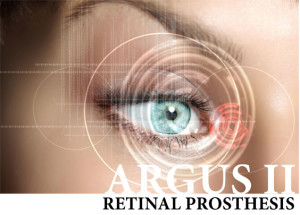By Netan Choudhry, M.D, FRCSC and Jennifer George
 More than two decades ago, development began on a technology that would revolutionize treatment for those suffering from age-related eye diseases like macular degeneration and retinitis pigmentosa (RP). In the ’80s and early ’90s, researchers at Johns Hopkins and DukeUniversities began testing the use of electrical stimulation of the retina to produce vision. This rudimentary work spearheaded the development of the bionic eye, finally removing it from the realm of science fiction and making it another exciting reality of cutting-edge medicine. The Argus® II retinal prosthesis system, developed by Second Sight, received FDA approval to restore limited vision to those blinded by retinitis pigmentosa, becoming the first-ever approved therapy for patients severely affected by RP.
More than two decades ago, development began on a technology that would revolutionize treatment for those suffering from age-related eye diseases like macular degeneration and retinitis pigmentosa (RP). In the ’80s and early ’90s, researchers at Johns Hopkins and DukeUniversities began testing the use of electrical stimulation of the retina to produce vision. This rudimentary work spearheaded the development of the bionic eye, finally removing it from the realm of science fiction and making it another exciting reality of cutting-edge medicine. The Argus® II retinal prosthesis system, developed by Second Sight, received FDA approval to restore limited vision to those blinded by retinitis pigmentosa, becoming the first-ever approved therapy for patients severely affected by RP.
Retinitis pigmentosa is a class of genetic disorders resulting in the progressive degeneration of the light-sensitive cells lining the region in the back of the eye known as the retina. These cells, called rods and cones, work like the film in a camera, capturing light images which are then translated into neural signals. These signals are sent to the brain for interpretation through the optic nerve. Affecting nearly 1.5 million people worldwide, RP, in its advanced stages, results in a total loss of vision. As the disease progresses, patients with RP experience a gradual loss of photoreceptor cells. In most cases, patients first develop the decay of rods. Rods, which are located primarily around the outer regions of the retina, are responsible for both peripheral vision and night vision. Night blindness (the inability to visually adjust to darkness) and subsequent tunnel vision are the two most common signs that one is suffering from retinitis pigmentosa. One might experience difficulty driving at night or lose one’s footing in dark rooms. The second most common form of the disease, cone-rod dystrophy, manifests in the loss of cones, the photoreceptors responsible for central vision and colour perception. Whether the decay begins with the rods or cones, patients suffering from RP will ultimately experience both central and peripheral vision loss.
Prosthesis utilizes electrical stimulation to replace the role of degenerated photoreceptors in the retina. Retinal prosthesis is similar to the cochlear implant technology that restores hearing to the hearing-impaired by stimulating the cochlea. The Argus II stimulates the retina, thereby restoring vision. This stimulation triggers the response of other neurons within the retina that have remained functional. The system works by using a video camera attached to a pair of glasses. This camera communicates wirelessly with a chip located on the retina. The camera within the glasses captures an image – a stop sign, for example – in the form of light and dark pixels. The image captured by the video is then processed by a portable unit and translated into instructions indicating “light” and “dark” that are sent back to the glasses. These instructions are sent wirelessly to the implant on the eye.
The image captured by the video is not immediately seen. Subjects require a degree of training in order to actually see the image. They begin by seeing dark and light spots, but gradually learn to interpret them. The system offers immense benefits for people who are suffering from blindness caused by RP, for whom therapy is currently unavailable. Second Sight will eventually adapt its technology to help those suffering with age-related macular degeneration. Candidates for the Argus II must have light perception vision in the better-seeing eye in order to qualify for the procedure.







